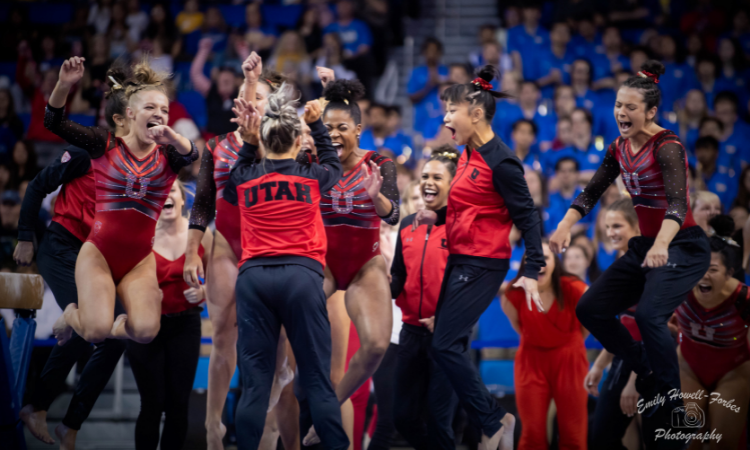Every handful of years, the buzzwords “conference realignment” become prevalent throughout the college sports landscape. Primarily driven by money and football, schools across the country reassess their current conference allegiance and potentially eye moves for more moolah. However, the impact extends well beyond the ball sports.
2011 was a major one in terms of conference realignment, with Colorado and Utah turning the Pac-10 into the Pac-12 starting in the 2011-2012 season. The Buffaloes jumped ship from the Big 12, almost bringing powerhouses Oklahoma and Texas with them while the Utes took the leap to a Power Five conference for the first time after competing in the Mountain West in most sports since the last extensive conference shift in 1999.
While Colorado has yet to grace our presence in gymnastics (still holding out hope), Utah has undoubtedly made its mark. Since the Mountain West didn’t support women’s gymnastics as a sport, the Red Rocks competed without conference affiliation from the 1994 season through 2011 before joining the Pac-12. Having lacked an opportunity to win a conference title for almost two decades, the Utes move to a power conference presented a prime opportunity.
“To your athletic director and to the department, those conference championships are a big deal,” said Greg Marsden, Utah’s head coach from 1976 to 2015. “In a sense, even more of a big deal than being second or third or fourth at [NCAA] championships. So for us to be invited and be in the Pac-12 was a big deal. Obviously, that was the most prestigious conference we’d had an opportunity to be in.”
Now through 11 seasons of Pac-12 gymnastics, the Utes have won four conference championship meets while never placing lower than third, have won at least a share of the three regular season championships since they began in 2020, and have yet to lose more than two Pac-12 meets in a single season. Utah didn’t quite fit the profile of the typical mid-major program making a jump to the major conferences, bringing nine previous NCAA championships to the table, which was likely the cause of the smooth transition.
The Red Rocks’ immediate success in the Pac-12 helped them avoid the usual biggest downside to making a conference switch: losing. Some programs, especially when moving to more competitive conferences, struggle initially to remain competitive.
“We understand our position in NCAA athletics and gymnastics, and we embrace that leadership role and we want to compete with the best teams,” said Tom Farden, current head coach of Utah who also served as an assistant under Marsden. “I was here when we were in the Mountain West, then I was here during the transition. So I saw what we were going to need in terms of recruiting, in terms of skill selection, in terms of how the rhythm of the conference was and then in terms of how hard it is to consistently win in any conference at a high level.”
The reach of Utah’s impact on the Pac-12 and vice versa extends well beyond the competition floor. Money is always a driving factor in any NCAA-related decision, and the Utes have benefitted well from the move. According to ESPN, Utah pulled in $79.4 million in revenue in 2016, which is a remarkable increase from its $25 million in revenue 10 years prior. The Pac-10 also lacked its own TV network, so after its 2011 expansion, the Pac-12 Network was born to compete with the likes of the Big Ten in both revenue and exposure.
“Obviously with us being in a Power Five conference, the visibility is incredible,” said Farden. “That’s just helped our overall budget and the strength of our athletics department. You can see the football program was in the Rose Bowl this year and won the Pac-12. So now we have three sports, baseball, gymnastics and football, that have been on top of our conference with gymnastics leading the way.”
While Marsden wasn’t included in any decision-making during the realignment process, the prestige of the Pac-10 and its schedule of already mainly Pac-10 foes made it the ideal landing spot for the Utes. Gymnastics was also likely not a factor in the decision, but the Red Rocks’ nine titles and consistently sold-out home meets surely made them an attractive choice.
“I think we brought our tradition to the Pac-12,” said Marsden. “I think we added strength to the conference. I’d like to think that we’ve encouraged people to up the ante because we’ve made it more competitive.”
READ THIS NEXT: The NCAA Report Card: March 16, 2022
Article by Brandis Heffner with additional reporting from Katherine Weaver
Like what you see? Consider donating to support our efforts throughout the year! [wpedon id=”13158″]




